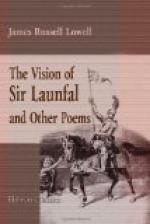97. Richest mail: The knight’s coat of mail was usually of polished steel, often richly decorated with inlaid patterns of gold and jewels. To serve his high purpose, Sir Launfal brings forth his most precious treasures.
99. Holy Grail: According to medieval legend, the Sangreal was the cup or chalice, made of emerald, which was used by Christ, at the last supper, and in which Joseph of Arimathea caught the last drops of Christ’s blood when he was taken down from the cross. The quest of the Grail is the central theme of the Arthurian Romances. Tennyson’s Holy Grail should be read, and the student should also be made familiar with the beautiful versions of the legend in Abbey’s series of mural paintings in the Boston Public Library, and in Wagner’s Parsifal.
103. On the rushes: In ancient halls and castles the floors were commonly strewn with rushes. In Taming of the Shrew, when preparing for the home-coming of Petruchio and his bride, Grumio says: “Is supper ready, the house trimmed, rushes strewed, cobwebs swept?”
109. The crows flapped, etc.: Suggestive of the quiet, heavy flight of the crow in a warm day. The beginning and the end of the stanza suggest drowsy quiet. The vision begins in this stanza. The nature pictures are continued, but with new symbolical meaning.
114. Like an outpost of winter: The cold, gloomy castle stands in strong contrast to the surrounding landscape filled with the joyous sunshine of summer. So the proud knight’s heart is still inaccessible to true charity and warm human sympathy. So aristocracy in its power and pride stands aloof from democracy with its humility and aspiration for human brotherhood. This stanza is especially figurative. The poet is unfolding the main theme, the underlying moral purpose, of the whole poem, but it is still kept in vague, dreamy symbolism.
116. North Countree: The north of England, the home of the border ballads. This form of the word “countree,” with accent on the last syllable, is common in the old ballads. Here it gives a flavor of antiquity in keeping with the story.
122. Pavilions tall: The trees, as in line 125, the broad green tents. Note how the military figure, beginning with “outposts,” in line 115, is continued and developed throughout the stanza, and reverted to in the word “siege” in the next stanza.
130. Maiden knight: A young, untried, unpracticed knight. The expression occurs in Tennyson’s Sir Galahad. So “maiden mail” below.
137. As a locust-leaf: The small delicate leaflets of the compound locust-leaf seem always in a “lightsome” movement.
138. The original edition has “unscarred mail.”
138-139. Compare the last lines of Tennyson’s Sir Galahad:
“By bridge and ford,
by park and pale,
All-armed I ride, whate’er
betide,
Until I find the Holy Grail.”




